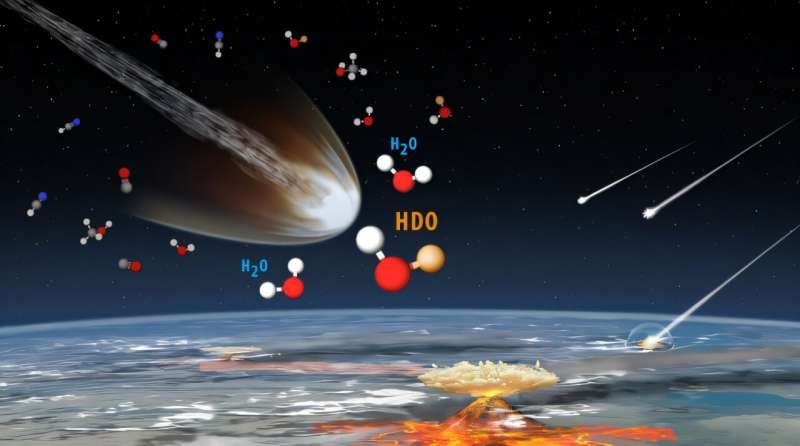Comets are like the archeological sites of the solar system. They formed early on, and their composition helps us understand what the area around the early Sun was like, potentially even before any planets were formed. A new paper from researchers at a variety of US and European institutions used the Atacama Large Millimeter Array (ALMA) to capture detailed spatial spectral images of comet 12P/Pons-Brooks, which is very similar to the famous Halley’s comet, and might hold clues to where the water on the Earth came from.
It might not be intuitively obvious just looking at it, but there are three types of water in Earth’s ocean. H2O, what we think of as regular water, is the most common, but there’s another, less common type known as semi-heavy water. Semi-heavy water replaces one of the hydrogen atoms in a water molecule with a deuterium atom – essentially a “heavy” version of hydrogen with two neutrons. About one in every 3,200 water molecules in the oceans is made up of this semi-heavy molecule, which is known as the D/H ratio. Even more rare is the true “heavy” water, where both hydrogen atoms are replaced with deuterium, which only happens in one in every 41 million water molecules.
The ratio of regular water to semi-heavy water has been of interest to astronomers for a long time as it can be used as evidence for where that water came from. There aren’t any biological or chemical processes that would change that ratio on a global scale, so it should be the same as when water was first delivered to Earth. Astronomers had long debated whether or not comets were that delivery mechanism, but data so far had been mixed as best about whether the ratio of semi-heavy water to water in the comets themselves was the same as that on Earth.
Fraser discusses the Oort Cloud, the source of many comets.
Most previous comets that had been observed had higher D/H ratios in the water in their coma than that of Earth’s oceans, calling into question whether they were the original source. However, more recently comets from other “families”, such as Oort-cloud comets and Jupiter-family comets, which have a distinct orbital path from Halley-types like 12P/Pons-Brooks, have been found to have the correct D/H ratio, bringing these interplanetary travelers back into the spotlight as a potential source of Earth’s water.
However, up until now, no one had yet found the correct D/H ratio in a Halley-type comet. That’s really the most important finding of the new paper – ALMA watched the coma of 12P/Pons-Brooks in April and May 2024, with one continual week-long observational period capturing data on the semi-heavy water in it, and a single day capturing the much stronger spectrographic signal of the normal water.
To reconcile these two observational times, and any changes that might have occurred between them, the researchers used a radiative transfer model based on methanol, another common cometary gas, as a proxy for the potential variability in the rate of water production. To prove this point, the researchers also utilized data from the NASA Infrared Telescope Facility to prove that the production rate of both methanol and water didn’t change. Importantly, this proved that both the water and semi-heavy water in the coma was being produced by sublimation from the nucleus, not through chemical reactions in the coma itself.
Dr. Paul Hartogh discusses the D/H ratio in comets. Credit – Serious Science YouTube Channel
One added feature of the ALMA data was its spatial resolution, and it was the first time that spatial data of these ratios was obtained for a Halley-type comet. While that particular finding didn’t have a major impact on the overall D/H ratio, it might be useful for future studies on the physics of comets. It can also be combined with spatial data from other types of comets that hint at an interesting theory – that, despite our different labels for them, they might have all come from the same place originally. The ratios are similar enough that the researchers suggest that the comets might have developed within 10AU of each other in the early solar system, essentially making only what happened to them afterward the differentiator between what we now view as different classes of comets.
More data is needed to prove that theory, but if it is true then comets are not only spectacular visitors that light up the sky every so often. They are a common thread that ties everything in the solar system together throughout its billion year history. While this paper in particular contributes to our understanding of that, and how they might have been the driving force of the creation of Earth’s oceans, there’s still a lot we don’t know about them – which means it is indeed time to collect more data.
Learn More:
NRAO – Halley-type comet’s water holds clues to life on Earth
M. A. Cordiner et al – A D/H Ratio Consistent with Earth’s Water in Halley-type Comet 12P from ALMA HDO Mapping
UT – Comet’s Water Reveals Clues About Life on Earth
UT – Earth Was Born With Water; No Delivery Needed
